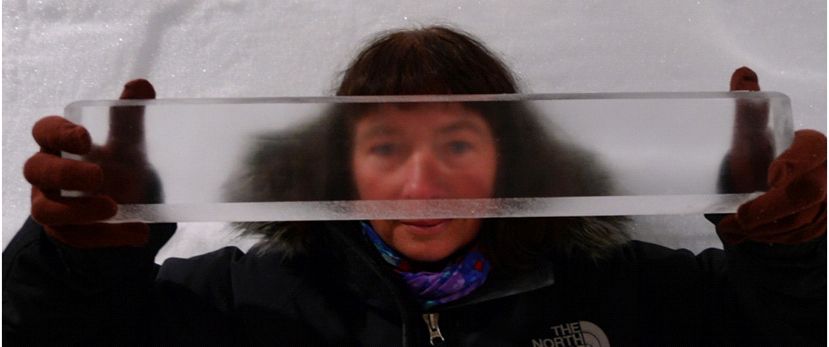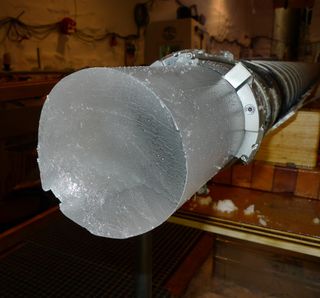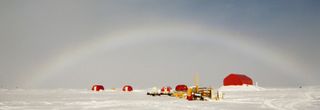Modern Greenland Melt Echoed in 126,000-Year-Old Ice

A new look at the melting of Greenland's ice sheet more than 115,000 years ago reveals that even though the climate was much warmer than today's, the ice was only a few hundred feet thinner than in modern times.
Given that sea level was also much higher during this long-ago period, the findings mean that Antarctica must have experienced major melt to boost the oceans. These results could hint at what's to come in today's warming world, the researchers report Thursday (Jan. 24) in the journal Nature.
"Even though the warm Eemian period was a period when the oceans were 4 to 8 meters higher than today, the ice sheet in northwest Greenland was only a few hundred meters lower than the current level, which indicates that the contribution from the Greenland ice sheet was less than half the total sea-level rise during that period," study researcher Dorthe Dahl-Jensen of the University of Copenhagen said in a statement.
Melting Greenland
Greenland is currently responding rapidly to global warming, shattering through the seasonal ice-melt record in the summer of 2012. Researchers estimate that Greenland has lost more than 200 million tons of ice each year since 2003, and recent models point to an ice sheet that is more sensitive to climate change than previously realized. In March 2012, European scientists reported in the journal Nature Climate Change that a rise of between 1.3 to 5.8 degrees Fahrenheit (0.8 to 3.2 degrees Celsius) in global average temperatures from preindustrial levels would melt Greenland's ice sheet entirely. Earth's surface temperatures are already up 1.3 degrees F (0.7 degrees C) from preindustrial temperatures, with average temperatures rising faster on the surface of Greenland. [Giant Ice: Photos of Greenland's Glaciers]

But these models are limited by the data scientists have. Understanding the future of Greenland's ice depends, in part, on learning how the ice sheet responded to temperature increases in the past. The international North Greenland Eemian Ice Drilling Project (NEEM) set out to drill deep into the ice sheet to reach layers of ice set down during the Eemian period a stunning 115,000 to 130,000 years ago.
This period was a warm interglacial, one of the many warm and cold periods the Earth has cycled through over the past millions of years. Today's rapid warming is driven not by these cycles, but predominately by emissions of greenhouse gases, which trap heat in the atmosphere, scientists say.
Sign up for the Live Science daily newsletter now
Get the world’s most fascinating discoveries delivered straight to your inbox.
Previous attempts to drill into Eemian ice turned up twisted and folded layers. This is the first time researchers have constructed a complete record of the climate from an Eemian ice core. They do this by looking at molecular variants called isotopes in the core, as well as trapped air bubbles that represent tiny time capsules of ancient atmosphere.
History of ice
The core revealed that temperatures in the Eemian peaked about 126,000 years ago, reaching about 14.4 degrees F (8 degrees C) hotter than the average temperature of the last millennium and warmer than climate models had estimated. Initially, more precipitation triggered by the warmer climate helped the ice sheet grow, rising in elevation about 689 feet (210 meters) higher than today. Eventually, however, the warm air caught up with the ice, diminishing it to about 427 feet (130 m) below its modern elevation.
The numbers reveal that despite the balmy temperatures, the ice sheet lost no more than 25 percent of its volume between 122,000 and 128,000 years ago. Additional calculations found that this much melt would have raised global sea levels by an average of about 6.6 feet (2 m). [Top 10 Surprising Results of Global Warming]
Total Eemian sea-level rise hit between 13 and 26 feet (4 to 8 m). Though water does expand when it gets warmer, some of the remaining mass must have been made up by melting in Antarctica, the researchers report.
"We now have evidence that confirms that the West Antarctic ice sheet was a dynamic and crucial player in global sea rise during the last interglacial period," Jim White, the U.S. lead on the NEEM project and an ice core expert at the University of Colorado, Boulder, said in a statement.

That's useful information for researchers trying to understand today's polar ice dynamics. Research released in November 2012 found that between 1992 and 2011, Antarctica lost approximately 1,320 metric gigatons of ice, compared with 2,940 metric gigatons lost in Greenland.
The good news is that Greenland's future ice melt may not be as bad as feared, at least if the Eemian is any model, Dahl-Jensen said. The bad news, she said, is that Antarctica may shed lots of ice in a warming world.
During their fieldwork, the researchers got a firsthand taste at what melting polar ice is like.
"We were completely shocked by the warm surface temperatures at the NEEM camp in July 2012," Dahl-Jensen said. "It was even raining and just like in the Eemian, the meltwater formed refrozen layers of ice under the surface. Although it was an extreme event, the current warming over Greenland makes surface melting more likely and the warming that is predicted to occur over the next 50 to100 years will potentially have Eemian-like climatic conditions."
Follow Stephanie Pappas on Twitter @sipappas or LiveScience @livescience. We're also on Facebook & Google+.

Stephanie Pappas is a contributing writer for Live Science, covering topics ranging from geoscience to archaeology to the human brain and behavior. She was previously a senior writer for Live Science but is now a freelancer based in Denver, Colorado, and regularly contributes to Scientific American and The Monitor, the monthly magazine of the American Psychological Association. Stephanie received a bachelor's degree in psychology from the University of South Carolina and a graduate certificate in science communication from the University of California, Santa Cruz.











